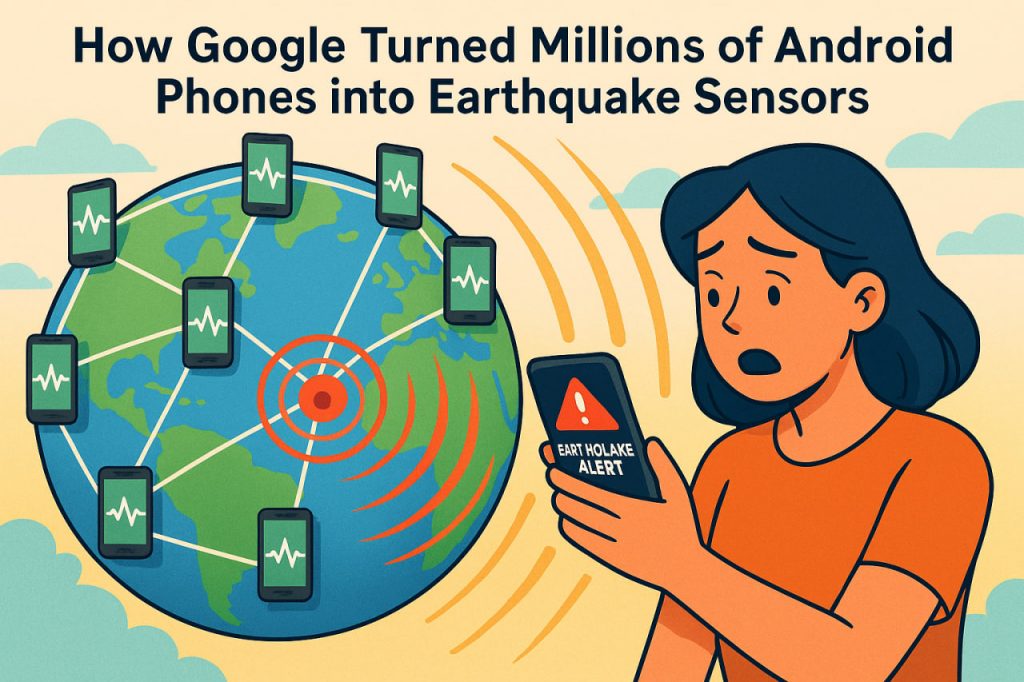In an extraordinary fusion of technology and seismology, Google has achieved what once seemed impossible: transforming millions of Android smartphones into a global network of earthquake detectors. This innovation represents a milestone in citizen science, leveraging the power of everyday devices to detect seismic activity and send early warnings to millions of people. By combining artificial intelligence, real-time data processing, and advanced sensors built into phones, Google has effectively created the world’s largest earthquake detection system—without building a single physical seismograph.
The Technology Behind the Idea
Every modern smartphone is equipped with an accelerometer, a tiny device that measures changes in movement and orientation. It’s what allows your screen to rotate or count your steps. Google engineers realized that these accelerometers could also detect subtle ground vibrations caused by earthquakes. When multiple nearby phones sense a similar pattern of shaking, the system can distinguish true seismic activity from everyday movements such as walking, driving, or dropping the phone. By analyzing these signals in milliseconds, Google’s servers can confirm an earthquake faster than traditional seismic networks.
The Role of Artificial Intelligence and Big Data
Machine learning plays a crucial role in this innovation. Google’s algorithms constantly analyze enormous streams of motion data from Android devices, filtering out noise and identifying earthquake-like patterns. Once an event is detected, the system compares incoming signals from thousands of other phones to confirm accuracy. The AI model learns continuously, improving its ability to distinguish between harmless vibrations and genuine seismic waves. The result is an adaptable, intelligent network that grows more accurate as more people participate.
How the Alert System Works
When Google’s servers confirm an earthquake, the system instantly sends alerts to nearby users via Android notifications. These warnings often arrive seconds before the main shockwave reaches the area, giving people just enough time to seek safety. Even a few seconds can make the difference between life and death—allowing trains to stop, elevators to halt, and individuals to take cover. In regions like Japan, Mexico, and California, this type of early warning has already saved countless lives, and Google’s approach expands this capability to areas without traditional seismic infrastructure.
Global Reach and Accessibility
One of the most powerful aspects of Google’s system is its inclusivity. Traditional seismograph networks are expensive and unevenly distributed—many developing countries lack them entirely. In contrast, Android phones are everywhere. As of today, billions of devices form a planetary-scale detection network that operates continuously and anonymously. Google has collaborated with the United States Geological Survey (USGS) and other seismic organizations to validate its data and improve accuracy. The result is a digital safety net that covers regions once considered unmonitored.
Challenges and Ethical Considerations
Despite its promise, this technology faces several challenges. Privacy is one of the biggest concerns: though Google claims the data is anonymized and used only for scientific purposes, some users remain skeptical about constant background monitoring. Accuracy can also be affected by false positives—instances where human movement mimics seismic shaking. To address these issues, Google continuously refines its algorithms and limits data collection strictly to motion-related signals. Balancing innovation with ethical responsibility remains central to the project’s long-term success.
The Future of Smartphone Seismology
The idea of crowdsourced earthquake detection opens new frontiers in global monitoring. In the future, smartphones could not only detect earthquakes but also analyze infrastructure health, measure air quality, and monitor climate changes in real time. By combining mobile sensors, satellite data, and AI analytics, humanity is building a digital nervous system for the planet—capable of sensing environmental changes instantly. Google’s project marks just the beginning of a new era where everyday devices contribute directly to scientific discovery and disaster prevention.
Interesting Facts
- The system uses accelerometers in Android phones to detect P-waves—the fastest seismic waves.
- Alerts often reach users 5–10 seconds before destructive waves arrive.
- Google’s network covers more than 90 countries, including areas without seismic stations.
- Traditional seismographs cost thousands of dollars each; smartphones achieve similar detection for free.
- The project began as part of Google’s Android Earthquake Alerts System, launched in 2020.
Glossary
- Accelerometer – A sensor that measures acceleration or vibration in a device.
- P-Waves (Primary Waves) – The fastest seismic waves that travel ahead of more destructive waves.
- Seismograph – An instrument that records ground motion during earthquakes.
- Machine Learning – A form of artificial intelligence where systems learn patterns from data.
- Crowdsourcing – Collecting information or services from a large group of people, often via technology.
- Early Warning System – A network designed to detect hazards and alert populations in advance.
- Anonymized Data – Information processed to remove personal identifiers.
- Big Data – Extremely large datasets analyzed computationally to reveal trends and patterns.
- USGS – The United States Geological Survey, a scientific agency studying natural hazards.
- Seismic Network – A system of sensors used to detect and analyze earthquakes.


